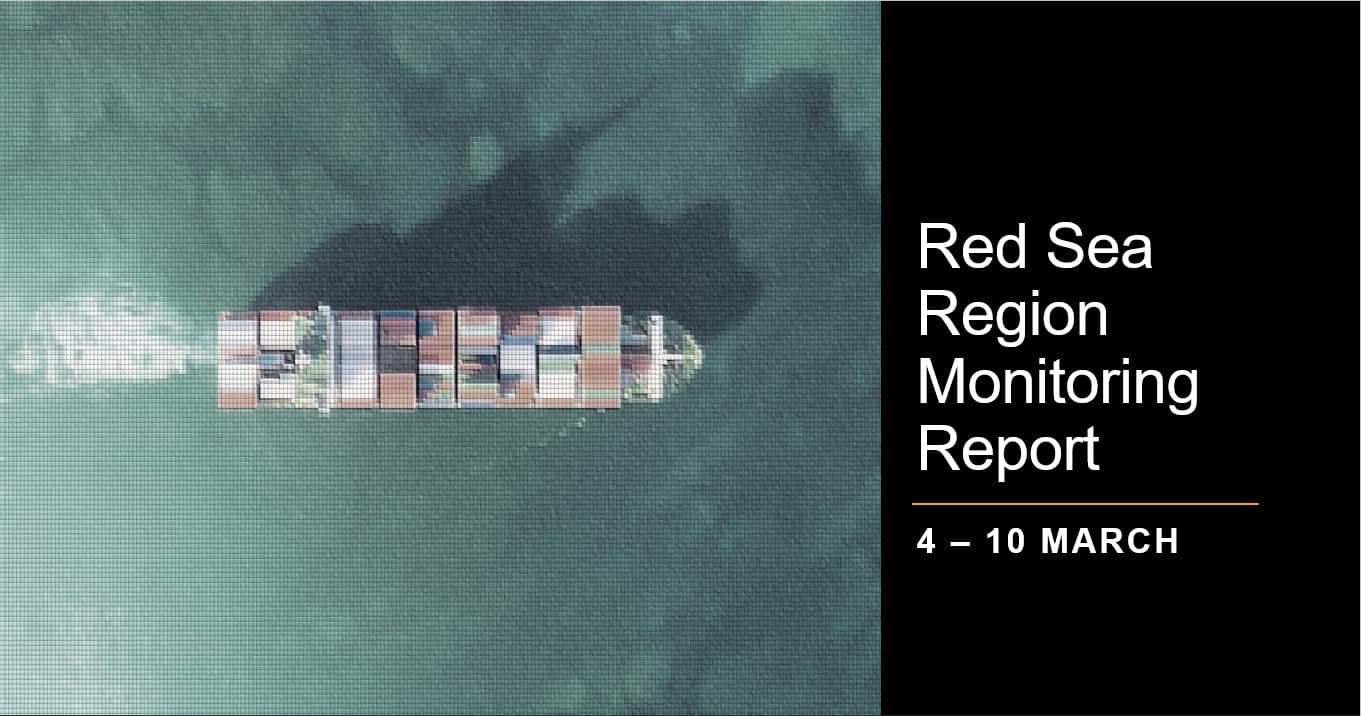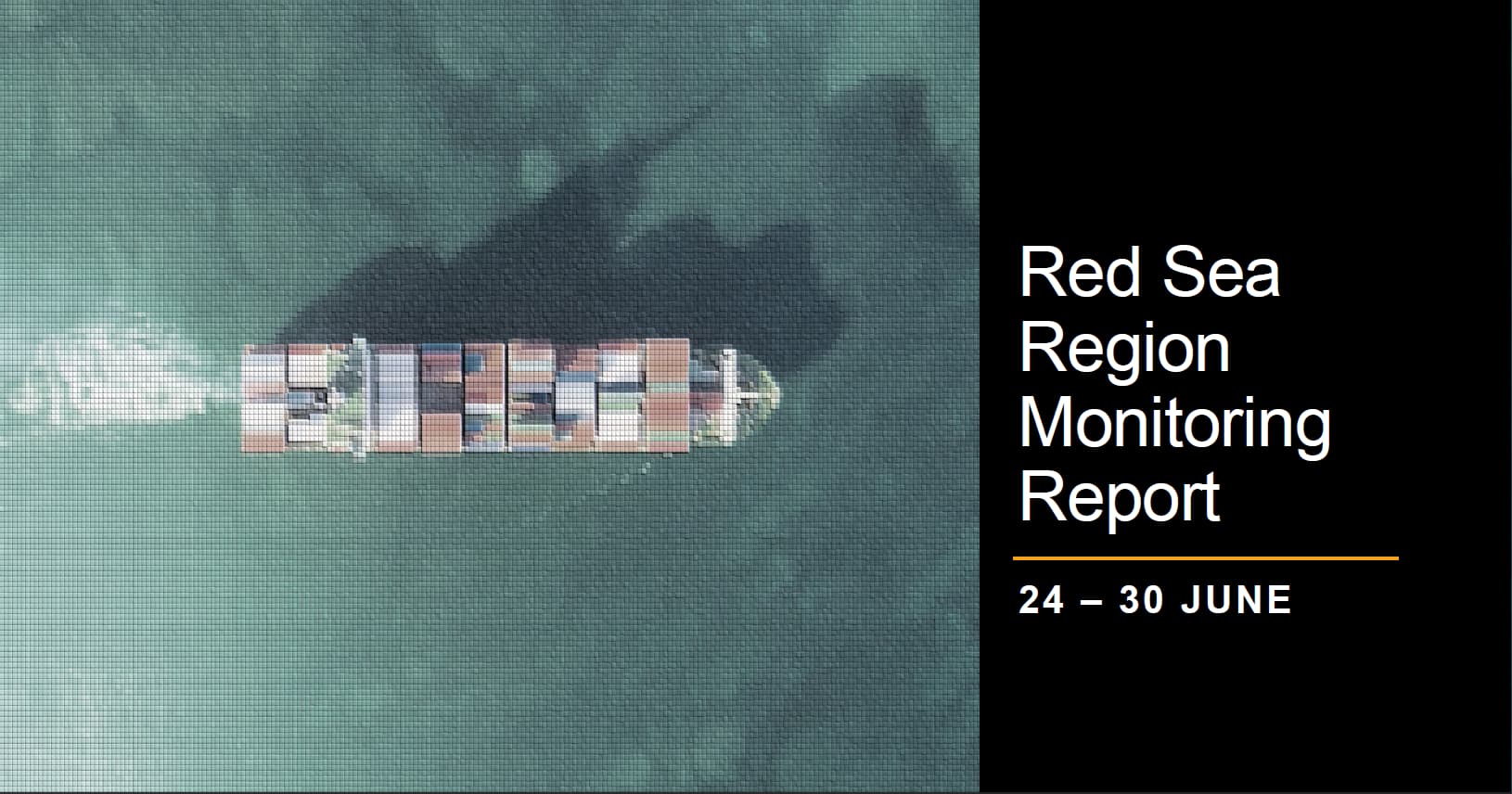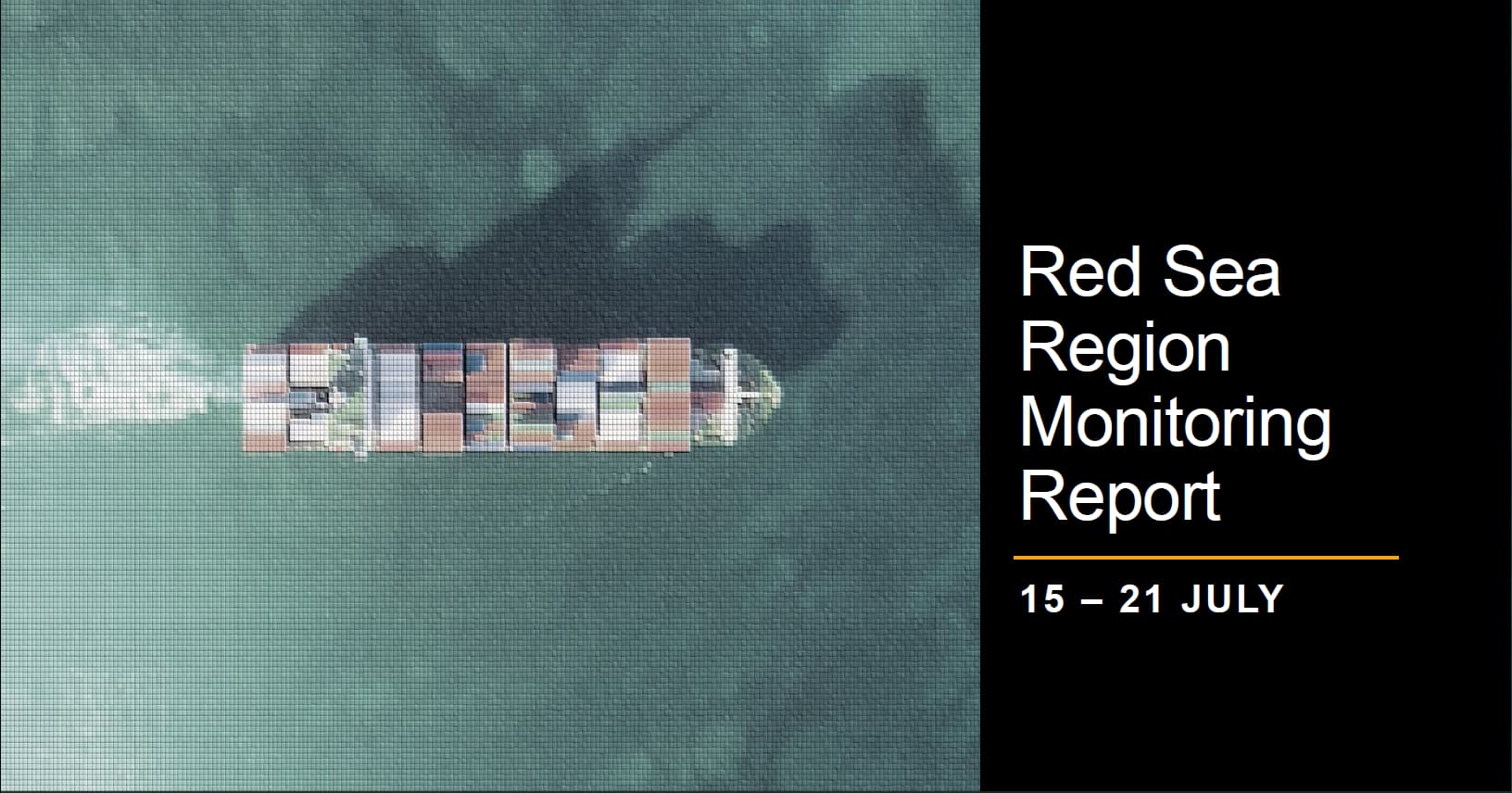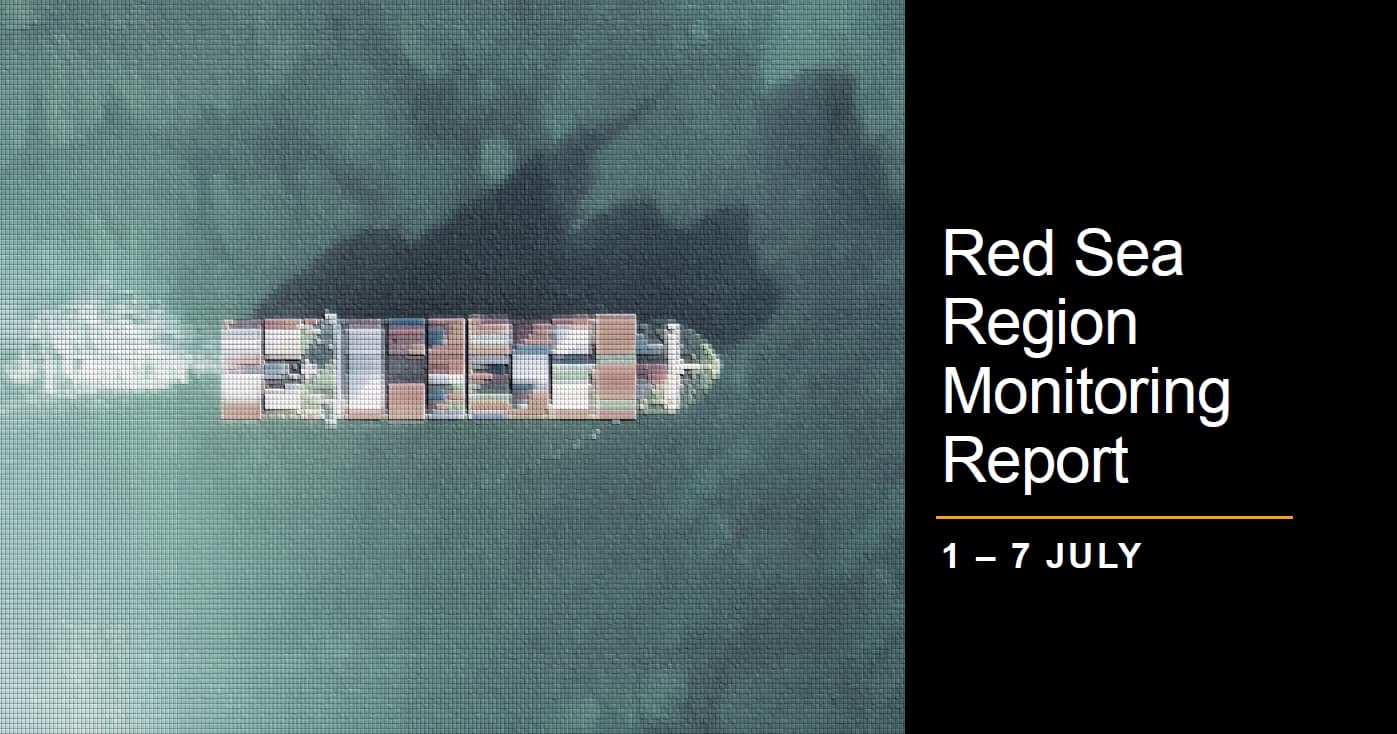KEY DEVELOPMENTS – COMMERCIAL INCIDENTS
During the monitoring period 4 – 10 March Regal Maritime Solutions (RMS) identified the following incidents in the Red Sea and Gulf of Aden region, obtained from a variety of open sources including UKMTO and the United States (US) military:
MISSILE STRIKE: On 4 March at approximately 91NM south-east of Aden the vessel MV MSC SKY II was reportedly targeted in a missile strike and sustained damage. The vessel and crew were reportedly safe and did not request additional assistance and proceeded to its next port of call.
SUSPICIOUS ACTIVITY: On 6 March a commercial vessel was reportedly hailed over VHF for approximately 30 minutes by an unknown user declaring itself as the Yemeni Navy and ordering the vessel to alter course in the vicinity of 50NM west of Aden.
MISSILE STRIKE: On 6 March approximately 54NM southwest of Aden the vessel MV True Confidence was struck by a missile and suffered damaged. Other vessels in the vicinity reported hearing a loud explosion and seeing a large plume of smoke at the time of incident. The vessel was subsequently abandoned by the crew and no longer under command (NUC). Coalition vessels arrived at the scene to provide assistance to the vessel and it’s crew.
MISSILE ATTACK: On 8 March at approximately 1615 local time, 50NM south-east of Aden the vessel MV Proper Fortune reported it had been targeted by a suspected missile strike, after two explosions were previously reported and had occurred in the vicinity of the vessel. The vessel was not damaged in the incident and crew were confirmed safe before proceeding to its next port of call.

KEY DEVELOPMENTS – MILITARY ACTIVITY
During the monitoring period 4 – 10 March RMS identified the following incidents involving US coalition forces in the Red Sea and Gulf of Aden region, obtained from military and open sources:
MISSILE ATTACK: On 4 March at approximately 0215 local time Houthi militants launched an anti-ship ballistic missile (ASBM) from Yemen into the southern Red Sea impacting the water with no reported damage or injuries to commercial or coalition warships.
MISSILE STRIKE: On 4 March, between 1550 and 1615 local time Houthi militants launched two anti-ship ballistic missiles (ASBMs) from Yemen into the Gulf of Aden at the M/V MSC SKY II, a Liberian-flagged, Swiss-owned container vessel. One of the missiles impacted the vessel causing damage. There were no reported injuries, and the vessel did not request assistance and continued with its voyage.
MISSILE INTERCEPT: On 4 March at approximately 2000 local time US forces conducted pre-emptive strikes against two anti-ship cruise missiles (ASBMs) that presented an imminent threat to commercial vessels and US Navy warships in the region.
MISSILE/UAV INTERCEPT:. On 5 March, between 1500 and 1700 local time US forces shot down one anti-ship ballistic missile (ASBM) and three one-way attack (OWA) unmanned aerial vehicles (UAVs) launched from Houthi controlled areas of Yemen toward the US warship, the USS Carney in the Red Sea. There were no reported injuries or damage to the ship.
MISSILE INTERCEPT:. On 5 March between 2045 and 2140 local time., US forces conducted pre-emptive strikes in Houthi controlled areas of Yemen, destroying three anti-ship missiles and three unmanned surface vessels (USV) in self-defense. US forces identified the missiles and USVs posed an imminent threat to commercial vessels and coalition warships in the region.
MISSILE STRIKE: On 6 March at approximately 1130 local time, an anti-ship ballistic missile (ASBM) launched from Houthi controlled areas of Yemen struck the MV True Confidence, a Barbados-flagged, Liberian-owned bulk carrier, whilst transiting the Gulf of Aden. The attack resulted in three fatalities amongst the multinational crew, an at least four injuries, three of which considered critical. There was also significant damage to the ship. The crew abandoned the ship and coalition warships responded to provide assistance.
UAV INTERCEPT: On 6 March at approximately 1915 local time US forces conducted pre-emotive strikes against two UAVs in a Houthi controlled area of Yemen that presented an imminent threat to commercial vessels and coalition warships in the region.
MISSILE/UAV INTERCEPT:. On 7 March between 1535 and 1655 local time US forces conducted pre-emptive strikes on four mobile Houthi anti-ship cruise missiles (ASCM) and one Houthi unmanned aerial vehicle (UAV) in Houthi-controlled areas of Yemen.
UAV INTERCEPT: During the afternoon on 7 March, US forces shot down three UAVs launched from Yemen toward the Gulf of Aden.
MISSILE INTERCEPT: On 8 March, at approximately 1000 local time US forces conducted pre-emptive strikes against two Houthi truck-mounted anti-ship missiles in Houthi-controlled areas of Yemen.
MISSILE ATTACK: On 8 March at approximately 1600 local time, Houthi militants launched two anti-ship ballistic missiles (ASBMs) from Yemen into the Gulf of Aden targeting MV Propel Fortune, a Singapore-flagged, owned, and operated vessel. The missiles did not impact the vessel and reported damage or injuries were reported.
LARGE-SCALE UAV ATTACK ON US AND COALITION WARSHIPS: On 9 March between 0400 and 0820 local time, Houthi militants launched two large scale attacks using one-way attack UAVs on US and Coalition forces in the Red Sea and Gulf of Aden. Coalition forces were able to identify and destroy 28 one way attack UAVs using warships and attack aircraft. No naval or commercial vessels were damaged during the attack.
KEY DEVELOPMENTS – HOUTHI MISSILE STATISTICS
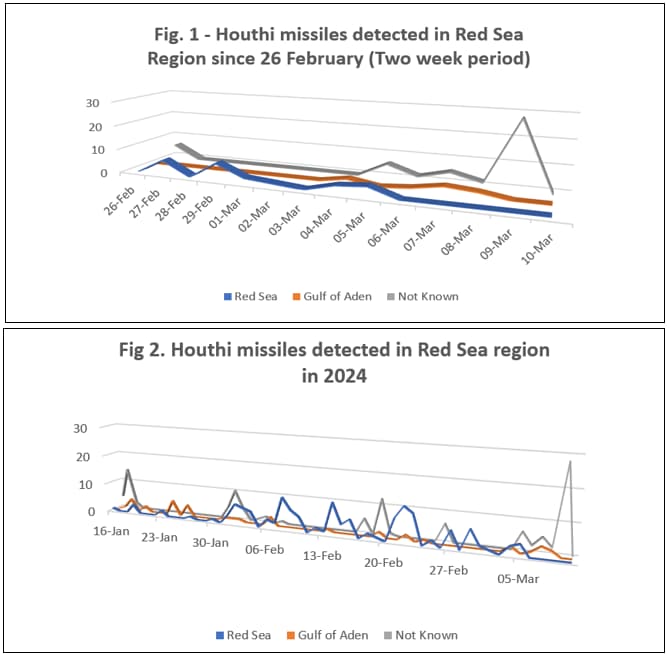
Figures 1 and 2 identifies the number of missiles, UAV, USVs and UUVs launched, or prepared to be imminently launched, by Houthi militants from Yemen targeting both commercial and naval vessels in the Red Sea and Gulf of Aden regions from data available from UKMTO, the US military and OSINT sources. Both figures have incorporated statistics from vessels hit, near misses and pre-emptive strikes on-land in Yemen by US-led Coalition forces but not those resulting from large scale coordinated military action. In some cases the destined target of Houthi weapons destroyed on-land in Yemen cannot not be verified and has therefore been categorised as ‘Not Known’ (NK). Where no dates are provided there were no reported incidents or data available for that period.
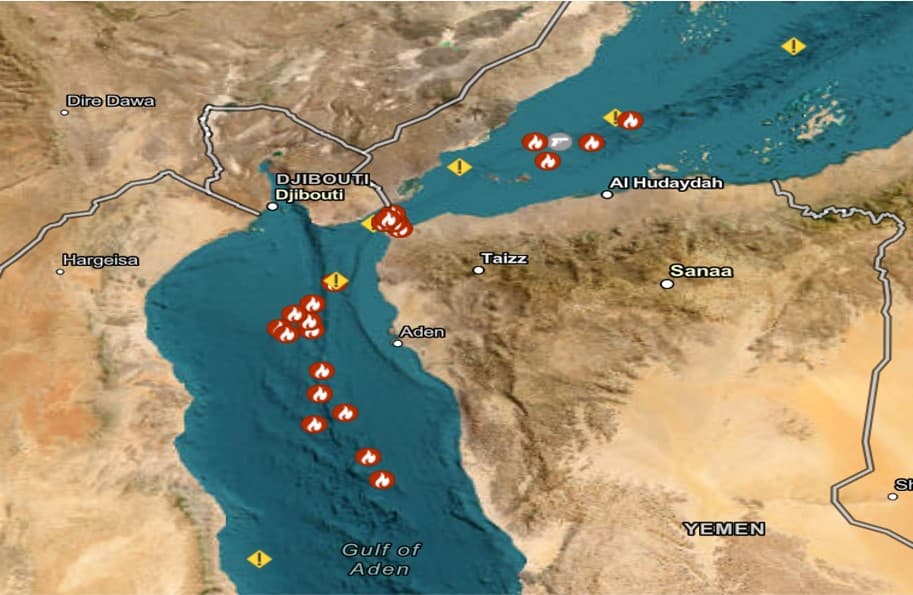
1 Jan – 10 Mar 2024
REGIONAL DEVELOPMENTS
During the monitoring period 4 – 10 March RMS identified the following key regional developments:
On 5 March US officials confirmed that undersea telecommunications cables in the Red Sea were cut disrupting 25 percent of data traffic between Asia and Europe with data being rerouted via other means as a consequence. The cables affected were the Asia-Africa-Europe 1, the Europe India Gateway, Seacom and TGN-Gulf lines. Investigators continue to attempt to identify whether the cables had been sabotaged or were a consequence of an accident. The Houthis have so far denied targeting the cables and continue to blame US and UK military operations for the disruption.
General Erik Kurilla of the US Central Command briefed the US Senate Armed Services Committee on 6 March following a visit to the Middle East region between 26 February and 2 March. Kurilla confirmed the US priority should be to deny the Houthis ability to resupply from Iran, as the Houthis are assembling the weapons systems in the country rather than building them.
Concern remains amongst US and UK officials that the Iranian intelligence vessel, the Behshad is back in operation and continuing to provide the Houthis tactical intelligence regarding vessel targeting in the Gulf of Aden. This follows a hiatus following a US cyber attack on the vessel. The Behshad was 43 nautical miles away when the MV True Confidence was struck by a missile on 6 March and follows a trend of increased Houthi attacks on commercial vessels when in operation.
On 6 March at approximately 1130 local time, an anti-ship ballistic missile (ASBM) launched from Houthi controlled areas of Yemen struck the MV True Confidence, a Barbados-flagged, Liberian-owned bulk carrier, whilst transiting the Gulf of Aden. The attack resulted in three fatalities amongst the multinational crew, an at least four injuries, three of which considered critical. There was also significant damage to the ship. The crew abandoned the ship and coalition warships responded to provide assistance. The deaths of the three crew members are the first fatalities of commercial crewmembers since Houthi attacks began in November 2023.
On 7 March, Houthi leader Abdul-Malik al-Houthi announced the group had carried out 96 missile and UAV attacks over the past five months, targeting 61 ships in the Red Sea and Gulf of Aden and has promised more surprises targeting its enemies. The Houthi militant group confirmed they have introduced submarine warfare into their operations, in the form of Unmanned Underwater Vehicles (UUV) reflecting the development of their military capabilities. They also reaffirmed that US and UK military strikes on Houthi targets in Yemen have done little to limit their capabilities to threaten shipping in the region.
On 7 March US President Joe Biden confirmed during his State of the Union address that the US military will construct a temporary port in Gaza with the objective of increasing the amount of humanitarian aid getting into the territory by sea, whilst pressuring Israel to do more in providing access to aid via its borders. This comes at a time of mounting pressure between the US and Israel regarding Israel’s conflict with Hamas in Gaza and growing humanitarian crisis in the territory..
Hamas delegates left Cairo on 7 March where talks to reach a deal for a ceasefire with Israel before the start of the Islamic holy month of Ramadan on 10 March stalled. Despite this indirect negotiations will continue.
On 9 March the Houthis launched at least two large scale aerial drone attacks targeting international naval forces in the Red Sea and Gulf of Aden. US, UK, French and Danish intercepted most of the UAVs. No naval or commercial vessels were reportedly damaged. Coalition forces confirmed to have intercepted and destroyed 28 one-way UAVs after Houthi militants claimed to have launched 37 UAVs in the attacks.
Iran is reportedly utilising Al-Hudaydah seaport in Yemen, which is under Houthi control, to facilitate its ongoing support to the group through the supply of finance and weaponry.
On 10 March, Saudi forces attacked the populated Yemeni border villages of Al-Thabet in the Qataber border district of the Saada governorate, placing further pressure on strained peace negotiations between both parties following the Saudi-led military intervention in 2015 in support of the Yemeni internationally recognised government (IRG)
Iranian, Chinese and Russian navies are expected to conduct naval exercises from 12 March until 15 March in the Gulf of Oman. The exercise coincides with increased tensions in the region as a consequence of the ongoing Israel-Hamas conflict and Houthi attacks on commercial vessels in the Red Sea region. The objective of the exercise is to focus on the protection of maritime trade, countering piracy and tackling maritime terrorism.
The Iranian Behshad intelligence collection vessel is located in the vicinity of coordinates 11° 06′ 11.0″ N, 044° 10′ 53.5″ E approxiamltey 29NM north east of Lughaya, Somalia at the time of this report.
ASSESSMENT
Houthi attacks will continue in the region and is expected to intensify, unless there is a ceasefire between Israel and Hamas, which would likely see a pause in attacks. The Houthis militant group will continue to target vessels in the region, in particular those with links, and/or tenuous links to Israel, the US and the UK.
Houthi militants will continue to be reliant on one way attack UAVs. Assembly facilities used to manufacture such weapons are spread across the northwest territory underground and in densely populated areas making them harder to target by US coalition forces.
Iran will continue to smuggle weapon components to Houthi militants via Al-Hudaydah port, shipping vessels and through arms smuggling networks within the territory controlled by Yemen’s internationally recognised government (IRG).
Iran will seek to restrain Houthi ambition where necessary, should it look to compromise its wider strategic objectives for the region, or provoke the US or Israel to take escalatory military action against its regional proxies.
The long term threat posed to commercial shipping from the Houthi group in the region will very likely remain and likely see the international community seek to contain and treat the Houthi threat in the long term.
The US and its partners will continue to conduct pre-emptive strikes and large scale coordinated military strikes against Houthi targets on-land, as the US led coalition continues to seek ways to degrade Houthi capability.
The US will look to intensify effort to intercept vessels smuggling weapon components from Iran to the Houthis in Yemen in an attempt to stem the flow of such technology used in the targeting commercial shipping in the region.
The US and its partners will continue to face intelligence collection challenges on Houthi arsenal and capabilities on the ground in the short term, as they increase attempts to deploy intelligence collection assets to fill this intelligence requirement.
Military strikes and counter-strikes across the region between Israel, the US, Iran and its regional proxies is likely to continue to escalate via tit-for-tat retaliatory measures, whilst attempting to prevent direct conflict between key powers.
The US government will continue to pursue a diplomatic solution for the Israel-Hamas conflict with regional partners in an attempt to dissuade wider escalation in the region. The US and regional partners will continue to pursue a ceasefire between Israel and Hamas in an attempt to alleviate pressure on the humanitarian situation in Gaza.
The deployment of EUNAVFOR military assets to the region, whilst increasing available resource to protecting commercial vessels and provide intelligence, it is highly unlikely to dissuade continued Houthi attacks or impact their capabilities in-land.
Piracy incidents around the Horn of Africa is expected to rise as a consequence of Somali fishing policy and opportunism by Somali based Piracy Action Groups (PAGs) seeking to take advantage of the security vacuum that has emerged along the east Africa coastline as a consequence of Houthi attacks in the Red Sea region.
RECOMMENDATIONS
Avoid vicinity of Iranian Behshad vessel.
Be aware of potential US, coalition or Israeli Navy activity nearby in north of Red Sea, Bab-al-Mandab strait and Gulf of Aden.
Report any Suspicious Sightings and be aware of the risk of Unmanned aerial Vehicle (UAV) / drone and Uncrewed Surface Vehicle (USV) attack.
Consider utilising a digital monitoring system, which incorporates UAV/UUV drone monitoring to warn of potential attack and use of physical barriers, such as nets and underwater barriers, that can be deployed to prevent UUVs from approaching a ship. These barriers can entangle or obstruct the movement of a UUV.
Ensure crew conduct drills and training exercises to respond to UUV threats so that they are well-prepared to take appropriate action in the event of an incident.
Follow guidance on loitering munitions as per the OCIMF website: https://www.ocimf.org/publications/information-papers/loitering-munitions-%E2%80%93-the-threat-to-merchant-ships
Implement and review BMP5 in particular section 2, which describes non-piracy threats and the Global Anti-Piracy Guide.
Consider mentioning vessel location to Flag Authorities.
Inform UKMTO/MSCHoA of vessel movements.
Ensure radar is kept on.
Communicate with local agents for any local information or intelligence.
Keep VHF Ch16 on and pay attention to advisories. Ensure strict surveillance of communications and establish communication with all approaching vessels.
Do not allow small boats to approach or dock.
Ensure there is Hard Cover available if on deck and that it is accessible.
Ensure a Secondary Muster Station is considered and identified to crew and not just the citadel.
Maintain Bridge Watches. (Please be aware at night, small, slow vessels without a wake are difficult to detect on radar).
Keep Traffic on Upper Deck to a minimum
Ensure all fire-fighting equipment is checked and available for immediate use. Including the emergency fire pump and that relevant maintenance has been conducted.

